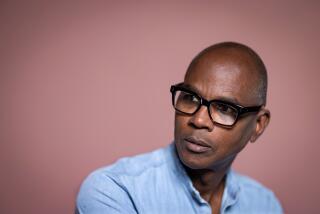âSoul Stirring: African American Self-taught Artists from the Southâ at CAAM
The exhibition âSoul Stirring: African American Self
-Taught Artists From the Southâ arrives at a troubling moment.
From North Carolina to Texas, the resurgence of a new era of race-related social and political restrictions is being decried as a new Jim Crow. It coincides with a controversial recent Supreme Court ruling that negates a powerful core of the landmark 1965 Voting Rights Act. And our on-going gilded age perpetuates and amplifies privilege.
At the California African American Museum, seven of the showâs eight artists, all now deceased, were born or began to make their paintings, drawings and mixed media works under the cloud of an American apartheid -- an era when state and local laws enforced segregation and other discrimination. Several of those seven are among the Southâs most well-known self-taught African American artists.
CHEAT SHEET: Fall arts preview 2013
At least since the momentous 1982 exhibition ââBlack Folk Art in America: 1930-1980,â organized by the Corcoran Gallery of Art in Washington, D.C. and sent on a lengthy national tour, awareness of a rich vein of previously unknown talent has only grown. The CAAM show does not add to the scholarly study of the work â there is no catalog â but it does offer a welcome opportunity to see a variety of powerful work.
Some are classic examples.
Nellie Mae Rowe (1900-82) developed a personal mythology in which her own deeply held spiritual commitments are given free reign. The crayon drawing âPeaceâ shows a marvelous blue animal in a golden field, its ecstatic face framed by a rendering of the artistâs own adoring hands.
âHouse of Worship,â a watercolor and ink drawing by Sister Gertrude Morgan (1900-80), celebrates her evangelism. A church, portrayed as a domestic refuge as much as a holy shrine, emphasizes the nurturing role of a âhouse.â Meanwhile, Morgan shows herself dressed in her trademark white clothing, like a spiritual nurse dispensing healing words, scrawled across the sheet.
PHOTOS: Arts and culture in pictures by The Times
Emancipation â both social and spiritual -- is the theme of âNo More,â a heartfelt painting on a discarded scrap of metal by Sam Doyle (1906-85). It centers on a slave-master wielding a broken and ineffectual whip, flanked by kneeling black field workers on the right and Abraham Lincoln and a celebratory horn-blower on the left. Above, the ensemble is captioned with the words of a liberating hymn.
Paintings on wood by Purvis Young (1943-2010), carved and painted wood reliefs by Leroy Almon (1938â97) and Herbert Singleton (1945-2008) and small paintings on canvas or board by Clementine Hunter (1886â1988) are also among the 52 assembled works, lent from seven public and private collections around the country. (Half come from the collection of Gordon W. Bailey.)
The eighth artist is of a different, younger generation. New to me, Roy Ferdinand stands out in this company of his elders, which is no mean feat.
Ferdinand was born in 1959. For more than a dozen years, prior to his untimely death from cancer at age 45, he chronicled life in gritty neighborhoods in and around New Orleans. If most of the showâs other artists view daily life, political turmoil and social struggle through a common spiritual lens, often associated with the black church, his seven large, mixed-media drawings are notable for their secular commitments.
ART: Can you guess the high price?
In a 1998 self-portrait, Ferdinand stands astride the stoop of a run-down urban house â a decked-out dude lording it over a trio below, who are carousing. His head and upper torso are framed by a battered screened-window, as if an exalted portrait-within-a-portrait in the scruffy scene. The artist shows himself blithely giving the group the finger.
Or, is he flipping the bird at us, standing on the outside looking in?
Probably both. His stretched drawing style of scratched lines and angular forms is all playfully sharp elbows.
The scene resonates like a visual tuning fork, thanks to a glimpse of a zippered artistâs portfolio shown leaning against the wall behind Ferdinandâs swaggering figure. Charged poles of self-destruction and self-creation reverberate.
A posthumous survey of Ferdinandâs work was organized for Prospect.1, the New Orleans biennial, in 2008. (Some 2,000 drawings are said to be known.) On the evidence, a full retrospective would be something to see.
California African American Museum, 600 State Dr., Exposition Park, (213)744-7432, through April 6. Closed Mon. www.caamuseum.org
More to Read
The biggest entertainment stories
Get our big stories about Hollywood, film, television, music, arts, culture and more right in your inbox as soon as they publish.
You may occasionally receive promotional content from the Los Angeles Times.











